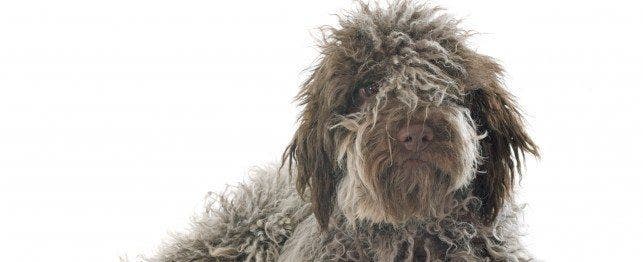
Choosing a Lagotto Romagnolo
The Lagotto Romagnolo hails from Italy and its name translates to “lake dog from Romagna.” These ancient, curly-haired dogs have functioned primarily as gun dogs and water retrievers in their home country, although more recently they are also being used to search for truffles. Interestingly, the Lagotto Romagnolo is the only recognized truffle-hunting breed!
History and Origin of the Lagotto Romagnolo
Lagotto Romagnolos were first noted in the lowlands of Comacchio and the marshlands of Ravenna back in the 16th century. Many experts believe that all water retrievers can trace at least part of their lineage back to the Lagotto Romagnolo. Their ability to hunt, retrieve, and swim is highly ingrained thanks to their breeding; however, if the Lagotto is to become an expert truffle hunter, he must be taught that skill from a young age.
Appearance and Size of the Lagotto Romagnolo
Standing 16-19 inches and height and weighing 24-35 pounds, the Lagotto Romagnolo has a curly, woolen-looking coat. Their coats are waterproof and can come in a variety of colors, from cream to brown, or even white. Some also have roan, orange, or brown patches. Their thick coats are not highly shed. Their large, dark eyes are quick to register motion, a holdover from their early days as hunters and retrievers.
Personality of the Lagotto Romagnolo
Like other working breeds, the Lagotto Romagnolo loves to have a job and needs daily physical and mental exercise. The breed is loving and affectionate towards family, but can become mischievous or destructive if not properly and regularly exercised. Being highly intelligent, this breed craves mental stimulation and can excel in dog sports such as tracking, obedience trials, or even agility.
Home and Family Relations with the Lagotto Romagnolo
While the Lagotto Romagnolo generally has a reputation for being a good family companion, families with small children should ensure the Lagotto is properly socialized to children from a young age. The breed can also peacefully coexist with other household pets. Because their coats are low-shedding, those with allergies may find this breed to be more “hypo-allergenic” than many other breeds. Families with a backyard for their Lagotto should know that the breed enjoys digging, so care should be taken to protect landscaping from unwanted excavation.
Training of the Lagotto Romagnolo
The Lagotto Romagnolo is highly intelligent and thus, loves to learn and use its brain on a regular basis. Training should begin at an early age, and should consist of short, frequent sessions with positive reinforcements given as rewards (such as food, praise, or play). The Lagotto is a willing student, always eager to learn and work.
Grooming of the Lagotto Romagnolo
Grooming the Lagotto Romagnolo generally consists of occasional brushing. Many breed experts also recommend keeping the coat trimmed to about 1 ½ inches in length to keep mats at bay. The breed may grow long bangs that cover their eyes, so regular trimming around the eyes is also recommended. As always, regular ear cleaning, tooth brushing, and nail trims are recommended.
Special Care of the Lagotto Romagnolo
As previously stated, the Lagotto has a special affinity for digging. In addition, they love to get dirty: rolling in mud or dirt, jumping into a lake on a whim, or sticking their heads into a hole they’ve recently dug. Due to their highly intelligent nature and active mind, they require not only physical exercise but mental stimulation as well. Interactive toys or games are recommended to keep the Lagotto from becoming bored and thus, destructive.
Common Diseases and Disorders of the Lagotto Romagnolo
Although the Lagotto Romagnolo is a relatively healthy breed, the following conditions have been observed:
Life Span of the Lagotto Romagnolo
The life span of the Lagotto Romagnolo is approximately 16 years.